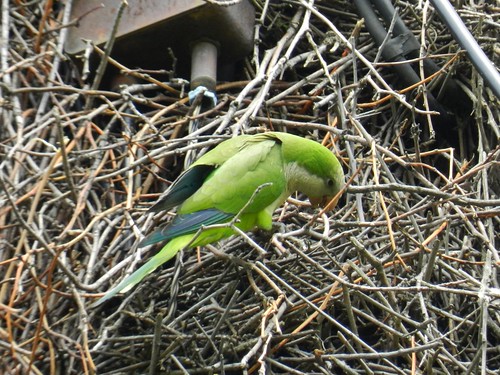Parrot Troopers Defend Their Feathered Friends
 Friday, December 31, 1999 at 17:01
Friday, December 31, 1999 at 17:01  Monk Parakeet Performing Some Nest Maintenance. Image by John W. Iwanski.They are bright green and they are feathered and, this being Hyde Park, they already have their own legal representation and defense fund.
Monk Parakeet Performing Some Nest Maintenance. Image by John W. Iwanski.They are bright green and they are feathered and, this being Hyde Park, they already have their own legal representation and defense fund.
They are the monk parakeets of Hyde Park, and they are the subjects of a flap between a U.S. Department of Agriculture office and Hyde Parkers who have come to regard the birds as local landmarks.
The USDA`s Animal Damage Control office in Springfield has announced plans to move the birds elsewhere to prevent their spreading outside Chicago and destroying crops.
In their native South America, they are an agricultural pest, eating grain and fruit crops. But in Hyde Park, their supporters say, they eat only dandelion seeds, shrub berries and, in winter, seed left at neighborhood bird feeders.
Parakeet lovers organized a picnic in defense of the parakeets Friday. Above, the parakeets squawked loudly in the ash tree where they have built four huge nests, just north of 53d Street and west of Lake Shore Drive. On the ground, pigeons scavenged for potato chips.
Attorney Robert Stone, a Hyde Park resident who is spearheading the opposition to removing the parakeets, handed out cards announcing the establishment of the Harold Washington Memorial Parrot Defense Fund at Hyde Park Bank & Trust Co.
Washington, who lived in an apartment overlooking the bird nests, was devoted to the birds and often pointed them out to interviewers.
Several passersby stopped to ask picnickers what was going on. "We`re out here supporting our parrots," Stone told them.
The small green birds, whose native habitat includes temperatures that do not drop below 20 degrees, were first spotted in Hyde Park in 1980.
No one knows how they got there. They may have been pets that escaped, or whose owners tired of them.
There are now about 50 parakeets, and many Hyde Park residents adore them. Ellen Goldsmith watches from her window as they add to their distinctive nests, which contain separate compartments for mating pairs. "They`re always schlepping these big twigs around," she said.
"Sometime they will gather on the fire escape, 12, 15 of them," said Corinne Benedetto, a University of Chicago student. "It might wake you up, but it sounds very nice."
Paul Waggoner, who organized the picnic and showed up wearing a green hard hat with white letters spelling, "Parrot trooper," said the birds fit nicely with his work as head of an art club that concentrates on works from different cultures.
"To find we have an esthetic element right here in Chicago from South America, it was a natural direction for me," he said.
"We are a nation of immigrants, and so are they," said Pat Mueller, a doctor.
Narahjan Gittoes, president of a flooring company, said he plans to hook a wireless remote video camera and a wireless remote 16-mm. camera to the ash tree where the main nests are and film a documentary on the parakeets.
"I think of them as my parrots, as does everyone in Hyde Park," said Stone. "Whenever a professor comes in from Europe and I give him a tour of Chicago, I drive by and point out the parrots."
Concern arises from the fact that the parakeets come from somewhere else. Ronald Ogden, ADC animal control director in Illinois, has said they could become as destructive as starlings, another non-native species.
Starlings have spread rapidly since their introduction in this country in 1890. They have caused significant agricultural damage and annoyed countless citizens by gathering in large, screaming flocks and depositing their wastes en masse.
"It`s not a fair comparison," responded Stone. "The starling is an ugly little bird that survives by kicking songbirds out of their nests and taking over. Monk parakeets are beautiful, and are not parasitic."
"In the eight years they`ve lived in Hyde Park, there is no indication they`re competing with other birds or they`re going to be harmful by going into fields," said Douglas Anderson, head of the Chicago Audubon Society and a Hyde Park resident. "Certainly they`re not attacking vegetable gardens or anyone`s orange trees."
The USDA has no formal policy on monk parakeets. "They are a threat to agriculture in other countries. They have not been here," said George Abraham, animal damage control director for the eastern region, which includes Illinois.
Ald. Lawrence Bloom (5th) has taken up their cause, although the birds are actually 4th Ward residents. "I`d like to keep them unless there is overwhelming evidence that we are creating a hazard for other people," he said.
Ogden told him no action will be taken until a public hearing is held in Hyde Park after Ogden returns from vacation May 10.
Hyde Park resident Nancy Hays urges reason. "Much as I like the birds, I don`t want them here if they`re going to be a plague," she said. "This has gotten to be so emotional on both sides."
Nonetheless, Stone is prepared to file suit to force the Animal Damage Control office to complete an environmental impact statement before moving the birds. The birds will have a friend in court, as well as in the park.
"I feel so flattered they picked this neighborhood," Goldsmith said.
"I mean, they could have picked somewhere else."

